Tagged With ‘grass’
Etat Libre d’Orange
You Or Someone Like You
25 August, 2017
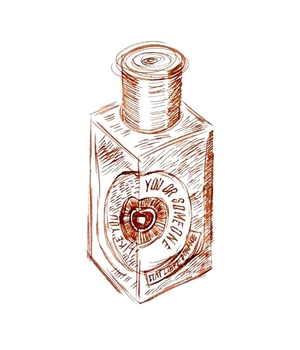 Victor Hugo, Tom of Finland, Tilda Swinton and the Marquis de Sade may not, on the face of it, have a great deal in common, but they have all inspired perfumes from the French niche-fragrance brand Etat Libre d’Orange.
Victor Hugo, Tom of Finland, Tilda Swinton and the Marquis de Sade may not, on the face of it, have a great deal in common, but they have all inspired perfumes from the French niche-fragrance brand Etat Libre d’Orange.
You Or Someone Like You is a collaboration with American perfume critic Chandler Burr, inspired by (and named after) his first novel, a comedy of manners set in Los Angeles, which I’d highly recommend. Though Burr points out that his perfume is not intended as an ‘olfactory landscape painting’, the heroine of his book is a keen gardener, and the scent he’s created with perfumer Caroline Sabas is as fresh as a spring morning in Beverly Hills.
Zingy citrus, rose, sharp grass and delicious hit of spearmint make for an addictively refreshing summer cologne – so addictive, in fact, that my bottle is already half empty.
The Library of Fragrance
Pipe Tobacco etc
7 August, 2015
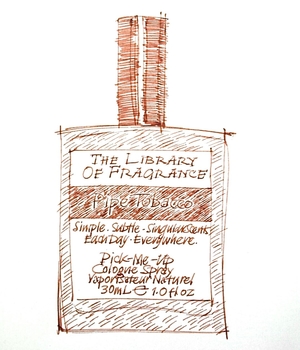 This is the first time I’ve reviewed a brand rather than a single perfume, and it may be the last, but there’s a reason for that. The Library of Fragrance describes its products as ‘Simple. Subtle. Singular Scents. Each Day. Everywhere’, and I wouldn’t quibble with any of that, other than the word ‘subtle’, which not all of the fragrances can really claim to be.
This is the first time I’ve reviewed a brand rather than a single perfume, and it may be the last, but there’s a reason for that. The Library of Fragrance describes its products as ‘Simple. Subtle. Singular Scents. Each Day. Everywhere’, and I wouldn’t quibble with any of that, other than the word ‘subtle’, which not all of the fragrances can really claim to be.
There are over 300 scents to choose from in the full range, and most of them are based on a single idea, from Apple Pie to Wet Garden. They’re cheap, cheerful and, above all, intended to be fun: something to spritz with or spray into the air for a quick hit, whether it’s as conceptual as Moonbeam, as simple as Mango or as playful as Play-Doh or Paperback.
I like them a lot, since they’re a reminder that perfume can be silly and fun as well as sexy and sophisticated (and occasionally pretentious and pestilential). They’re a great introduction to the world of fragrance, especially for anyone who can’t afford to spend £80 a time, and some of the conceptual scents are genuinely interesting – Dirt is deservedly popular, as is Snow and Thunderstorm.
Given their price compared with the stratospheric cost of top-quality raw materials, I wouldn’t necessarily recommend their takes on so-called ‘naturals’ like Neroli or Iris, but The Fragrance Library makes no great claims for its ingredients, unlike some brands that really should know better. The bottles are small (30ml or 1 fluid ounce) and the perfume concentration is low, between 2% and 8%, which in industry jargon counts as a ‘cologne spray’, but then in the UK they currently sell at just £15 a time. Part of the range can now be found in larger branches of Boots, which I think is great, and the rest is available online.
Some of the scents I’ve mentioned may sound familiar, and that’s because they used to be available in the UK under the Demeter brand, which was founded in Pennsylvania in 1994 by the maverick perfumer Christopher Brosius, who’d previously worked for Kiehl’s. Demeter’s early fragrances included Tomato, Dirt and Grass, and the brand quickly gained a cult following, in Britain as well as the USA, but management disagreements led to Brosius leaving in 2004 to set up on his own as CB I Hate Perfume. Demeter is still going strong in the USA, but because of trademark restrictions it can’t use the Demeter brand name in Europe– thus The Library of Fragrance. Start exploring it here.
Lalique
Encre Noire
15 April, 2015
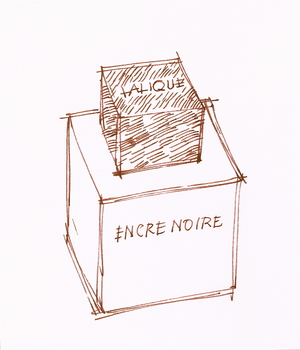 Calling a perfume ‘black ink’ has intriguing connotations. ‘Black’ or ‘Noir(e)’ has been the perfume industry’s shorthand for ‘edgy’ ever since the 1998 launch of the striking but hard-to-wear Bulgari Black. Among the many followers in its wake we’ve had Ambre Noir, 1881 Black, Armani Privé Cuir Noir, Bois Noir, Coco Noir, Cologne Noir, Dahlia Noir, Datura Noir, Eau Noir, Fourreau Noir, even (I kid you not) Hello Kitty Noir.
Calling a perfume ‘black ink’ has intriguing connotations. ‘Black’ or ‘Noir(e)’ has been the perfume industry’s shorthand for ‘edgy’ ever since the 1998 launch of the striking but hard-to-wear Bulgari Black. Among the many followers in its wake we’ve had Ambre Noir, 1881 Black, Armani Privé Cuir Noir, Bois Noir, Coco Noir, Cologne Noir, Dahlia Noir, Datura Noir, Eau Noir, Fourreau Noir, even (I kid you not) Hello Kitty Noir.
So Encre Noire (which was launched in 2006) follows a bit of a bandwagon, though at least its name is better than most. It’s a nostalgic name, since hardly anyone uses ink (black or otherwise) these days, yet it’s evocative too – I can kind of imagine the smell of black ink, even though I must have been a teenager the last time I opened an actual bottle of the stuff.
Whatever you think about the name, Encre Noire is a fine addition to the many men’s perfumes to be based on the smell of vetiver, the vigorous tropical grass whose roots have a wonderful dry, earthy, slightly musky scent. My all-time favourite is Guerlain’s simply-named Vétiver, which starts with a burst of lemony freshness, but Encre Noire foresakes such tricks and sticks resolutely with vetiver all the way through.
I say ‘all the way through’, but of course it’s actually a bit more complicated than that, thanks to Nathalie Lorson, senior perfumer at the giant Swiss fragrance company Firmenich. When she created Encre Noire she cleverly smoothed off some of vetiver’s rough edges, adding tiny amounts of cypress extract (which has a dry, woody, slightly resinous smell), as well as synthetic musk and so-called ‘cashmere wood’. This is actually 2,3,5,6,7-hexahydro-1,2,3,3-pentamethyl-4h-inden-4-one, a chemical sold under the brand name of Cashmeran, which is widely used in perfumery (and household products) and has a soft, gently woody smell.
The final result an appealing and long-lasting perfume, though some people are always going to find vetiver too dry and bitter-smelling for their taste. As for the bottle, a black glass cube with a square wood-effect cap, I like its inkwell look, but its glossy surfaces all too quickly get smeared with fingerprints, and the lettering is so spare – just a bare ENCRE NOIRE in thin white sans-serif capitals – that (to me at least) it ends up looking a bit cheap and half-considered, though I’m sure it was anything but.
Minor gripes aside, this is a fine perfume, and even if, in the end, I think it’s unlikely to supplant Guerlain’s Vétiver in my affections, I think its popularity is well deserved.
Frederic Malle
Cologne Bigarade
10 January, 2015
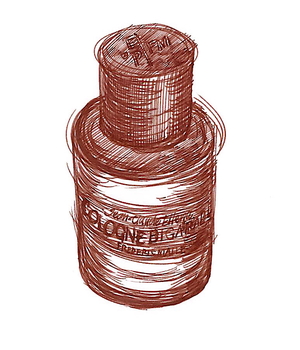 Every morning for my breakfast I have tea, toast and home-made marmalade. It’s one of my favourite things, and I love the bittersweet smell of Seville oranges, which only appear in the shops for a couple of weeks around this time of the year.
Every morning for my breakfast I have tea, toast and home-made marmalade. It’s one of my favourite things, and I love the bittersweet smell of Seville oranges, which only appear in the shops for a couple of weeks around this time of the year.
In fact as I sit here writing this post in January, Roy is busy cooking marmalade next door, and the powerful odour of bitter orange (known as bigarade in French) is suffusing the house from kitchen to attic.
So it could hardly be a better time to review Cologne Bigarade, created by the perfumer Jean-Claude Ellena for the French fragrance curator and marketeer, Frédéric Malle (nephew of the film director Louis Malle). Launched in 2001, it was one of the first of the Editions de Parfums Frédéric Malle, and to my mind it’s one of the most immediately appealing and easy to enjoy.
On first – I was going to say ‘glance’, but I suppose I should say ‘spritz’, it smells like a simple but high-quality natural scent, with the exact mix of sweet green freshness and slight bitterness that you get from orange peel and its bitter pith.
You could, I guess, just bottle Seville-orange extract and have done with it – and apparently Jean-Claude Ellena did commission a special new essence for this scent, obtained by molecular extraction. But like all good perfumes Bigarade Cologne is ultimately a clever recreation of what seems, on the surface, like a simple natural scent, using a careful balance of other ingredients to enhance and support the main ingredient.
In this case, Ellena has added a bit of hay and grass – or rather their synthesised essences – which makes the orange even fresher somehow, then subtly underpinned it with a little cedar-wood and rose, adding extra depth and staying-power. You could even say that these extra ingredients suggest the smell of the leaves and the twigs of orange trees, though perhaps that’s going too far.
(Actually, unless you concentrate very hard you can’t really smell them at all; but then we’re so suggestible when it comes to scents that once someone has told you that a particular ingredient is present, you’re more than likely to ‘smell’ it whether it’s actually there or not.)
To me Cologne Bigarade also has a very slight and not unpleasant sweatiness, which (from a short trip to the kitchen and back) is part of the authentic Seville orange smell. In perfume that faint sweatiness is often derived from cumin, and I wonder if there might be a touch of that classic curry spice here too.
Cologne Bigarade is not, perhaps, the most complex perfume on the market, but like most of Jean-Claude Ellena’s fragrances it’s rather more thoughtful and unusual than the general run. Given that he’s also the in-house perfumer for Hermès, it immediately made me think of Hermès’ classic Eau d’Orange Verte, which is also based on the scent of bitter oranges. Though that perfume was originally created by Françoise Caron in 1979, Ellena developed a new version in 2004 called Concentrée d’Orange Verte.
Eau d’Orange Verte is one of my all-time favourite fragrances, yet comparing them side by side, it smells sharper and fresher, but perhaps also slightly less interesting than Cologne Bigarade, which also seems to have much more staying power (a rare quality in a citrus-based cologne, though you can also find it in the fantastic sherbet-lemon Monsieur Balmain).
All the fragrances in the Editions de Parfums Frédéric Malle are expensive, and Cologne Bigarade is no exception, even if its packaging is extremely smart. The heavy, plain-glass bottle has a chunky black cap and comes in a slide-out, black foam-padded box, which in turn slides out (with some effort) of a scarlet card wrapper. If you have money to burn then there’s an even more expensive version called Bigarade Concentrée, which I’ve smelled as a sample and lasts even longer than Cologne Bigarade. The concentrated version also seems to have less of that faint sweatiness about it, which I suspect many people would prefer; I think I do too.
Either way, a fresh but unusual cologne is a wonderful thing to have, so full marks to Jean-Claude Ellena and Frédéric Malle for giving men something a bit different to wear. In a similar vein, though with a very different smell, is Malle’s Geranium Pour Monsieur, which I hope to be able to review before long; watch this space.
Heeley
L’Amandière
19 November, 2014
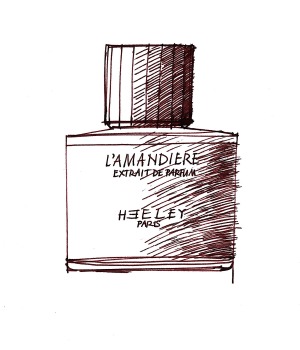
Well-heeled and well-spoken, with a passing resemblance to the young Bruce Chatwin, James Heeley is a Paris-based product designer and perfumer. We’re told that he was born in Yorkshire, studied philosophy in London and then worked as a lawyer, before moving to Paris in the late 1990s, where he changed tack again and began designing vases for star French florist Christian Tortu.
Through Tortu he met Annick Goutal, the legendary pianist turned model turned independent perfumer, which must have been an inspiring introduction to the world of perfume. Heeley describes himself as a self-taught perfumer, and though he commissioned his first few fragrances he now creates the initial olfactory compositions himself.
At £170 for a 50ml bottle of ‘Extrait de parfum’ (which you can buy online from Les Senteurs), L’Amandière is breathtakingly expensive, but at least it has the grace to look like it, coming in a bottle whose surprisingly hefty weight belies its size. Its design is crisp and simple, as you’d hope from a product designer, with a simple black label and a chunky black faceted cap.
Heeley calls his latest fragrance ‘a portrait of spring’, and adds ‘I tried to include many of the scents that my girlfriend loves (including almond) and assemble them to create an imaginary, spring orchard.’ He may have intended it as a woman’s perfume, but what you smell first is light and rather refreshing combination of almond oil and fresh-cut grass – both of which have hints of bitterness (in almond’s case) and sourness (in the case of green grass), which prevents L’Amandière coming across as too floral and girly.
It does have its floral side thanks to the pastel softness of mimosa, but because the almond scent predominates in the end its associations end up reminding one more of food than flowers – though without the cloying sweetness of other food-related fragrances like vanilla or chocolate.
On a woman I think it would smell perfectly pleasant, but on a man it’s much more interesting and unusual, which is why I’m recommending it here. It has surprisingly good staying-power too, which is a good thing given how much each spray has cost you. One for the connoisseur.
Hermès
Eau de Narcisse Bleu
10 October, 2014
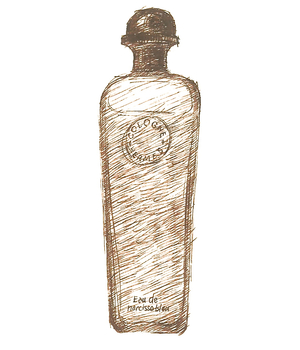 Pretty much everyone I know loves Hermès’ deliciously fresh and zingy Eau d’Orange Verte, so when Eau de Narcisse Bleu (literally ‘blue narcissus water’) was launched in 2013 it had a tough act to follow. As I’ve never seen a blue narcissus / daffodil, I think it’s safe to say that this perfume has an element of fantasy about it, and as a smell, too, it’s perhaps rather more complex and a little less instantly accessible than its predecessor. But give it a little time and I think it’ll grow on you.
Pretty much everyone I know loves Hermès’ deliciously fresh and zingy Eau d’Orange Verte, so when Eau de Narcisse Bleu (literally ‘blue narcissus water’) was launched in 2013 it had a tough act to follow. As I’ve never seen a blue narcissus / daffodil, I think it’s safe to say that this perfume has an element of fantasy about it, and as a smell, too, it’s perhaps rather more complex and a little less instantly accessible than its predecessor. But give it a little time and I think it’ll grow on you.
Eau de Narcisse Bleu may not have the euphoric mood-lifting freshness of Eau d’Orange Verte, but it has a gentle softness that, once you’ve smelled it for a while, is extremely appealing in its own right. It does have the faint sweetness of real daffodil flowers (try sticking your nose in one on a sunny day next March and you’ll see what I mean), but what narcissus extract smells of most, rather unexpectedly, is fresh hay. *
Now, I have nothing against smelling of hay, which is a lovely scent in its own right, but what Hermès’ much-mythologised perfumer, Jean-Claude Ellena, has done is blended the smell of hay with a whole raft of subtly complementary fragrances. Most of them are quite ‘green’ – that is, they smell fresh and natural, like grass and leaves, but not especially sweet or flower-like.
To me it has a slight but definite scent of fig-leaves, which for anyone who loves L’Artisan Parfumeur’s wonderful Premier Figuier as much as I do can only be a good thing. Whether this figginess is (excuse the pun) a figment of my imagination I’m not sure, but among the other ingredients that Ellena lists is galbanum, which is extracted from the root of a wild Iranian plant that looks a bit like fennel or cow-parsley, and indeed is distantly related to them.
Galbanum has a marvellously fresh sappy smell like newly-snapped pea-pods, and is one of the most important components of ‘green’ perfumes, but its greenness, here, is tempered by the hay-like sweetness of narcissus, with a hint of earthy bitterness underneath which manages to stop it from smelling at all girly.
If my description makes it sound a bit complicated, don’t be put off, for it’s such a well-blended perfume that there’s nothing discordant about it. In fact if anything it is, perhaps, a little too gentle for its own good, as it’s a ‘quiet’, thoughtful scent that stays close to your skin and doesn’t, on the whole, grab other people’s attention. It’s discreet and refined, in other words, rather than a ‘look-at-me’ perfume, which is perfect if you want to smell good without drawing attention to yourself. Go try it.
* I say ‘narcissus extract’, but one of the irritating things about perfume marketing is how vague – and frankly clueless – most descriptions of perfume ingredients actually are. For as anyone who actually grows the things themselves knows full well, a bright-yellow daffodil like Narcissus ‘February Gold’ smells very different to Narcissus papyraceus, the so-called paperwhite narcissus; the former has a gentle, hay-like scent, while one of the big selling-points of paperwhites is their powerful, almost jasmine-like perfume, the sweetness of which, en masse, can have a touch of the slightly repellent stagnant-water smell that perfumers refer to as ‘indolic’. If only perfume PRs were taught some basic botany.
Postscript – mystery solved, but only by going to the source: in France last week I visited IFF-LMR, the legendary natural raw perfume materials company near Grasse, and what should we get talking about but their narcissus extract, which is derived from the beautiful Narcissus poeticus, fields of which grow wild in the uplands of the Lozère. Did they use other species of daffodil as well? No, came the answer, and it’s their extract that you’re smelling (among many other things) in Eau de Narcisse Bleu.
More recent releases…
25 July, 2014
So many new men’s fragrances come out every year that it would be a full-time job to review them all – and probably not a very rewarding one. But while I’m keen to celebrate my favourites on The Sniff Box, it seems only polite to give brief reviews to some of the recent releases that I’ve kindly been given by perfume companies, even if they don’t (in my view) merit a longer review.
I took the first of these, DKNY MEN ENERGIZING EAU DE COLOGNE SPRAY, into an office where I was working and asked my male colleagues to tell me what they thought of it. After some consideration and a surprising amount of sniffing, they came back with, ‘It’s the kind of bottle you’d expect to see in a teenage boy’s bedroom, but actually it’s not as bad as we expected.’
Personally I think it’s almost indistinguishably generic and very synthetic-smelling, with none of the refreshing citrus of a classic eau-de-cologne, though it is faintly cucumberish or melony. The bottle, incidentally, is an unfeasibly tall rhomboid with a naff transfer of the Empire State Building up one side, a clear plastic cap and a spray button in electric blue. Teenage boy’s bedroom, in other words.
RENSHAW, from Murdock, is the latest cologne from a small British brand which has grown out of a chain of trendy barber shops owned by Irish-born Brendan Murdock. Renshaw was launched during Wimbledon week and, appropriately for a perfume with a tennis theme, smells like grass with a splash of sharp sweetness – though in this case it’s grapefruit, not strawberries. It’s perfectly pleasant, and probably perfect for its intended audience: describing itself as ‘British Cologne’, it’s a little bit Boy’s Own – not too fancy, complex or expensive.
The name JIMMY CHOO MAN gives me the uncomfortable image of a bloke in high heels, which I hope is unintentional. This first (but almost certainly not last) men’s perfume from the high-fashion shoe brand comes in a curved grey-glass bottle with rather 1970s-looking silver lettering, topped off with a matching metal plate and a metal-topped cap wrapped in faux snakeskin.
As for the fragrance itself, it smells at least as chemical as the DKNY Men Energising Eau de Cologne. Generic, in a word, and quite hard to distinguish from, say, Paul Smith Extreme Sport or a hundred other men’s fragrances from the last decade. Though it’s not being released until September, I won’t be holding my breath, though I might be holding my nose.